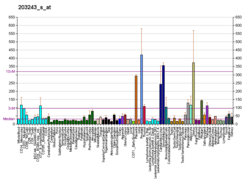PDLIM5
PDZ and LIM domain protein 5 is a protein that in humans is encoded by the PDLIM5 gene.[5][6]
The protein encoded by this gene is a LIM domain protein. LIM domains are cysteine-rich double zinc fingers composed of 50 to 60 amino acids that are involved in protein-protein interactions. LIM domain-containing proteins are scaffolds for the formation of multiprotein complexes. The proteins are involved in cytoskeleton organization, cell lineage specification, organ development, and oncogenesis. The encoded protein is also a member of the Enigma class of proteins, a family of proteins that possess a 100-amino acid PDZ domain in the N terminus and 1 to 3 LIM domains in the C terminus. Multiple transcript variants encoding different isoforms have been found for this gene, although not all of them have been fully characterized.[6]
Interactions
References
- 1 2 3 GRCh38: Ensembl release 89: ENSG00000163110 - Ensembl, May 2017
- 1 2 3 GRCm38: Ensembl release 89: ENSMUSG00000028273 - Ensembl, May 2017
- ↑ "Human PubMed Reference:".
- ↑ "Mouse PubMed Reference:".
- ↑ Wu M, Li Y, Ji C, Xu J, Zheng H, Zou X, Gu S, Lou Y, Xie Y, Mao Y (September 2004). "Cloning and identification of a novel human gene PDLIM5, a homolog of AD-associated neuronal thread protein (AD7c-NTP)". DNA Seq. 15 (2): 144–7. doi:10.1080/10425170310001656756. PMID 15346770.
- 1 2 "Entrez Gene: PDLIM5 PDZ and LIM domain 5".
- ↑ Kuroda, S; Tokunaga C; Kiyohara Y; Higuchi O; Konishi H; Mizuno K; Gill G N; Kikkawa U (December 1996). "Protein-protein interaction of zinc finger LIM domains with protein kinase C". J. Biol. Chem. UNITED STATES. 271 (49): 31029–32. doi:10.1074/jbc.271.49.31029. ISSN 0021-9258. PMID 8940095.
Further reading
- Sudo K, Chinen K, Nakamura Y (1995). "2058 expressed sequence tags (ESTs) from a human fetal lung cDNA library". Genomics. 24 (2): 276–9. doi:10.1006/geno.1994.1616. PMID 7698749.
- Bonaldo MF, Lennon G, Soares MB (1997). "Normalization and subtraction: two approaches to facilitate gene discovery". Genome Res. 6 (9): 791–806. doi:10.1101/gr.6.9.791. PMID 8889548.
- Kuroda S, Tokunaga C, Kiyohara Y, et al. (1997). "Protein-protein interaction of zinc finger LIM domains with protein kinase C". J. Biol. Chem. 271 (49): 31029–32. doi:10.1074/jbc.271.49.31029. PMID 8940095.
- Ueki N, Seki N, Yano K, et al. (1999). "Isolation, tissue expression, and chromosomal assignment of a human LIM protein gene, showing homology to rat enigma homologue (ENH)". J. Hum. Genet. 44 (4): 256–60. doi:10.1007/s100380050155. PMID 10429367.
- Nakagawa N, Hoshijima M, Oyasu M, et al. (2000). "ENH, containing PDZ and LIM domains, heart/skeletal muscle-specific protein, associates with cytoskeletal proteins through the PDZ domain". Biochem. Biophys. Res. Commun. 272 (2): 505–12. doi:10.1006/bbrc.2000.2787. PMID 10833443.
- Hartley JL, Temple GF, Brasch MA (2001). "DNA Cloning Using In Vitro Site-Specific Recombination". Genome Res. 10 (11): 1788–95. doi:10.1101/gr.143000. PMC 310948. PMID 11076863.
- Wiemann S, Weil B, Wellenreuther R, et al. (2001). "Toward a Catalog of Human Genes and Proteins: Sequencing and Analysis of 500 Novel Complete Protein Coding Human cDNAs". Genome Res. 11 (3): 422–35. doi:10.1101/gr.GR1547R. PMC 311072. PMID 11230166.
- Simpson JC, Wellenreuther R, Poustka A, et al. (2001). "Systematic subcellular localization of novel proteins identified by large-scale cDNA sequencing". EMBO Rep. 1 (3): 287–92. doi:10.1093/embo-reports/kvd058. PMC 1083732. PMID 11256614.
- Strausberg RL, Feingold EA, Grouse LH, et al. (2003). "Generation and initial analysis of more than 15,000 full-length human and mouse cDNA sequences". Proc. Natl. Acad. Sci. U.S.A. 99 (26): 16899–903. Bibcode:2002PNAS...9916899M. doi:10.1073/pnas.242603899. PMC 139241. PMID 12477932.
- Maeno-Hikichi Y, Chang S, Matsumura K, et al. (2003). "A PKC epsilon-ENH-channel complex specifically modulates N-type Ca2+ channels". Nat. Neurosci. 6 (5): 468–75. doi:10.1038/nn1041. PMID 12665800.
- Iwamoto K, Kakiuchi C, Bundo M, et al. (2004). "Molecular characterization of bipolar disorder by comparing gene expression profiles of postmortem brains of major mental disorders". Mol. Psychiatry. 9 (4): 406–16. doi:10.1038/sj.mp.4001437. PMID 14743183.
- Petroziello J, Yamane A, Westendorf L, et al. (2004). "Suppression subtractive hybridization and expression profiling identifies a unique set of genes overexpressed in non-small-cell lung cancer". Oncogene. 23 (46): 7734–45. doi:10.1038/sj.onc.1207921. PMID 15334068.
- Iwamoto K, Bundo M, Washizuka S, et al. (2004). "Expression of HSPF1 and LIM in the lymphoblastoid cells derived from patients with bipolar disorder and schizophrenia". J. Hum. Genet. 49 (5): 227–31. doi:10.1007/s10038-004-0136-5. PMID 15362566.
- Gerhard DS, Wagner L, Feingold EA, et al. (2004). "The Status, Quality, and Expansion of the NIH Full-Length cDNA Project: The Mammalian Gene Collection (MGC)". Genome Res. 14 (10B): 2121–7. doi:10.1101/gr.2596504. PMC 528928. PMID 15489334.
- Wiemann S, Arlt D, Huber W, et al. (2004). "From ORFeome to Biology: A Functional Genomics Pipeline". Genome Res. 14 (10B): 2136–44. doi:10.1101/gr.2576704. PMC 528930. PMID 15489336.
- Niederländer N, Fayein NA, Auffray C, Pomiès P (2005). "Characterization of a new human isoform of the enigma homolog family specifically expressed in skeletal muscle". Biochem. Biophys. Res. Commun. 325 (4): 1304–11. doi:10.1016/j.bbrc.2004.10.178. PMID 15555569.
- Kato T, Iwayama Y, Kakiuchi C, et al. (2005). "Gene expression and association analyses of LIM (PDLIM5) in bipolar disorder and schizophrenia". Mol. Psychiatry. 10 (11): 1045–55. doi:10.1038/sj.mp.4001719. PMID 16044170.
- Rual JF, Venkatesan K, Hao T, et al. (2005). "Towards a proteome-scale map of the human protein-protein interaction network". Nature. 437 (7062): 1173–8. Bibcode:2005Natur.437.1173R. doi:10.1038/nature04209. PMID 16189514.
- Horiuchi Y, Arai M, Niizato K, et al. (2006). "A polymorphism in the PDLIM5 gene associated with gene expression and schizophrenia". Biol. Psychiatry. 59 (5): 434–9. doi:10.1016/j.biopsych.2005.07.041. PMID 16213469.










